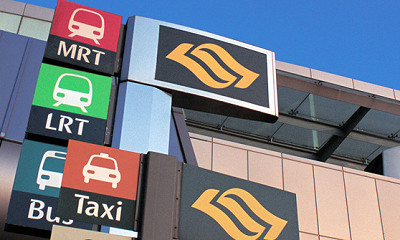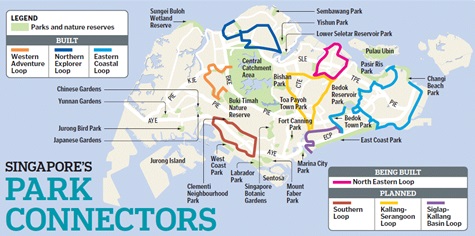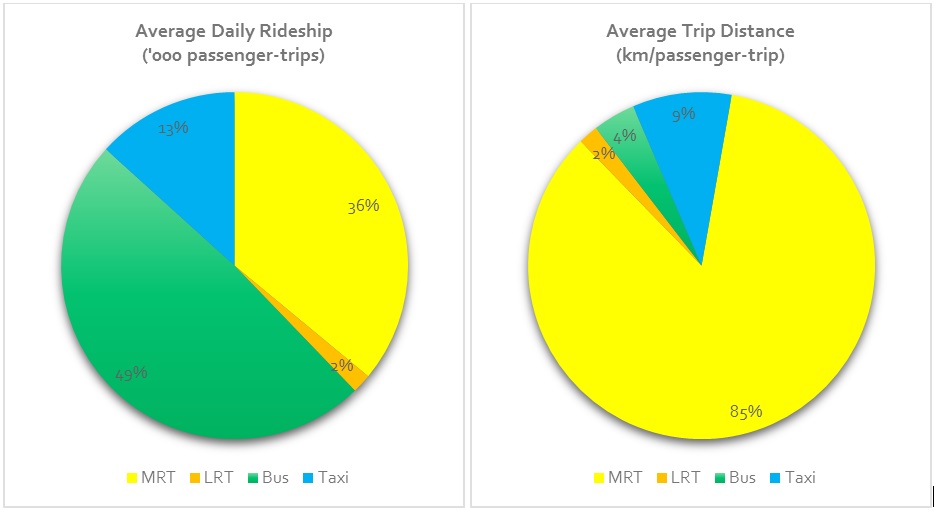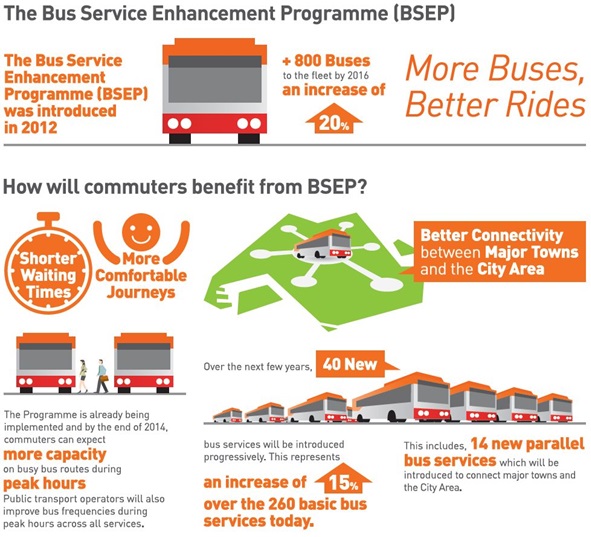Kami menggunakan cookies untuk membuat pengalaman Anda lebih baik. Untuk mematuhi petunjuk e-Pribadi yang baru, kami perlu meminta persetujuan Anda untuk menyetel cookies. Pelajari lebih lanjut .

How advance transportation in Singapore? And what is the future?
At the moment, Singapore together with Hong Kong, Tokyo, Seoul, and Beijing is leading with their transportation system. Not satisfied with the current system, Singapore has a long term plan to improve their transportation system. According to the Global Competitiveness Index (GCI) Report 2015/2016, overall, out of 140 countries, Singapore placed in second position behind Switzerland with USA and Germany following in third and fourth respectively. While the other five largest members of the Association of Southeast Asian Nations (ASEAN) are far behind: namely Malaysia (18th), Thailand (32nd), Indonesia (37th), the Philippines (47th), and Vietnam (56th).
Have a look more detail, the second pillar of the GCI is closely related to transportation: infrastructure. This pillar is concentrating on the assessment of the quality of transport infrastructure and the quality of electricity and telephony infrastructure. The assessment of the transport infrastructure consists of overall infrastructure, roads, railroads, ports, and air transports with their availability of airline seats. Regarding the quality of infrastructure, Singapore established their position also in second place, with Hong Kong leading at the first place. The rest ASEAN countries following behind: Malaysia (24th), Thailand (44th), Indonesia (62nd), Vietnam (76th), and Philippines (90th).
However, it is little bit unfair to compare Singapore with other ASEAN countries considering the land area. Not like other ASEAN countries, Singapore comparable with city scale. However, Singapore invests their 15% of total land area (12% for land transportation and 3% for ports and airports) only for transportation infrastructure. Hong Kong uses 5% of total land area for transportation infrastructure, while Jakarta has less than 7%.
|
Land Use |
Jakarta |
Singapore |
Hong Kong |
|
Residential |
76% |
14% |
6.9% |
|
Commercial and industrial |
6% |
13.7% |
2.7% |
|
Roads and rails |
10% |
7.6% |
3.9% |
|
Airports & ports |
|
11.7% |
1.2% |
|
Parks & Greeneries |
3% |
8% |
68.8% |
|
Total Land Area |
664 km2 |
714 km2 |
1108 km |
Source: Hong Kong Planning Department (2015), Singapore Ministry of National Development (2015), and BPLHD Jakarta (2015)
However, if we are talking about transport policies, UITP (International Association of Public Transport explains there are three pillars of sustainable transport that should be address:
- Integrated land-use and transport planning (and their environmental impact);
- Travel demand management; and
- Developing high quality public transport.
So, let’s discuss about the development of Singapore’s transportation related to these three pillars, one by one.
INTEGRATED LAND USE AND TRANSPORT
Singapore already implemented a policy called transit oriented development (TOD), a policy intended to maximize access to public transport by introducing a mixed land use. Singapore has started to build integrated transport hubs (ITHs) with high quality of service. ITHs are fully air-conditioned bus interchanges seamlessly linked to MRT stations, commercial area, and community facilities. With this integration, commuters can easily access the public transport and shop at the same place conveniently before and/or after transferring to their busses or trains. At the moment, there are eight of ITHs (Ang Mo Kio, Bedok, Boon Lay, Clementi, Sengkang, Serangoon Joo Koon and Toa Payoh) built with two more in Bukit Panjang and Yishun in 2016 and 2019 respectively.
Still, Singapore has high ambition to improve it. To make more convenient for the commuters, they built a sheltered walkways: 200 – 400 meters length from the stations. Yet, they want that all their stations are reachable within 10 minutes of walking. They also aim to have all the MRT stations and bus interchanges to be a barrier free by 2020. Furthermore, Singapore is promoting cycling. Since 1991, Singapore introducing a park connector network (PCN), roads specifically for walking/cycling which connect from one park to another. At the moment, they have more than 250 kilometers of PCN. In order to connect to ITHs, they are putting a bicycle parking at MRT stations and buses interchanges. By 2013, they will provide more than 700 kilometers of cycling paths. A bicycle sharing scheme also introduced. This is an alternative mobility option as a convenient and affordable means for short trips, yet a complement for the first-mile/last-mile connections. The proposed scheme is written under the Land Transport Master Plan 2013.

TRAVEL DEMAND MANAGEMENT
In order to manage their travel demand, Singapore strictly controls the growth of vehicle population by implementing Vehicle Quota System (VQS) to limit the vehicle ownership. The VQS applies to all private motor vehicles: cars, taxis, goods vehicles, buses and motorcycles. With VQS, everyone who wants to buy a vehicle must obtain the Certificate of Entitlement (COE) which is auctioned publicly. With this policy, Singapore is able to press down the vehicle growth until 0.5% per annum. As comparison, vehicle growth in Jakarta is up until 11% per annum. Shanghai also has similar policy. However, Shanghai only implement it limited to private cars only.
The second policy is the congestion charging. Electronic Road Pricing (ERP) system used in Singapore since 1998. ERP system has many advantages: minimizes traffic volume, optimizes usage of the road network and provides a fair price for motorists. ERP rates vary for different roads and time periods depending on local traffic conditions. In the future, LTA planned to improve their system by using Global Navigation Satellite System (GNSS) which not only will overcome the inflexibility of physical gantries but also possible to make a distance-based congestion charging. What do you think about ERP in Jakarta?

Figure 2. ERP in Singapore (source: www.lta.gov.sg)
More, LTA is introducing a Travel Smart Program to influence travel behavior change, to shift travelling commuters to off-peak periods and to encourage a switch to more sustainable modes of travel such as public transport, walking, cycling, car sharing and or reduce travel demand altogether. Travel smart basically based on the concept of redoing travel plan by evaluating and managing not only the commuters but also the companies or organization. Therefore, a flexibility of working can be achieved resulting travels during off-peak periods.
DEVELOPING HIGH QUALITY PUBLIC TRANSPORT
Singapore has many options when it comes to high quality public transport. Safety, reliability, capacity, and affordability are four main issues that they are really concern about public transport. While lately, the Transport Minister, Khaw Boon Wan, said that they aiming to have three in four commuters choose public transport as their main mode of travel by 2030, a proportion rising to 85 per cent by the 2050 (Channelnewsasia, 2016).

Figure 3. Average Daily Ridership and Trip Distance
Bus is very important in Singapore. Almost half of total commuters rely on this mode for commuting. LTA introduced a Bus Service Enhancement Program (BSEP) in 2012. At the moment, Singapore has more than 17.000 buses with 70 percent of them is equivalent or even younger than 10 years. Yet, they are planning to add another 1000 buses by 2017. LTA also implementing “City Direct Bus Services” which offers one ride from residence area to central business district (CBD). By now, at least already 10 residences are connected. More, Singapore has set a priority for buses: a specific bus lanes have been extended from 120 km to 150 km since 2008, regulation of all motorists must give way to buses at bus bays, and a signal priority for buses. Not only quantity and quality of the services are improved, but also the average speeds have been increased from 16 – 19 km per hour to 20-25 km per hour.

Figure 4. Bus Service Enhancement Program (BSEP) in Singapore
Mass Rapid Transit (MRT) and Light Rapid Transit (LRT) in Singapore is one of examples where their system produces profit. Atlantic.com reported that the farebox recovery ratio (the percentage of operational costs covered by fares) for Singapore was 125 percent, the second highest after Hong Kong with 185 percent. Two operators: SMRT and SBS Transit responsible to run these systems (also buses) including five lanes of MRT and three lanes of LRT with total length of 178 km with 142 stations. By 2030, they aim to extend their network to 360 km resulting most of households will live within 10 minutes of walking to the stations.
COLLABORATION WITH LEADING UNIVERSITIES AND GLOBAL RESEARCH INSTITUTES
In November 2015, at LTA Future Mobility Simposium, LTA signed agreements with three universities to improve innovation in transportation in the future. There will be three research centers from each university, these universities are: The Nanyang Technology University (NTU), National University of Singapore (NUS) and Singapore Institute of Technology (SIT). As the one who responsible for directions and objectives, A 12-member LTA Research Advisory Panel has been formed. (Thursday, 19th November 2015, Today newspaper).
Each three center will develop different areas of focus (some of them still overlapping).
- NUS center will focus on mobility behavior, green mobility, transport network optimization and structural engineering.
- NTU center will develop self-driving vehicles, MRT tunneling engineering, rail system inspection and condition monitoring and cybersecurity.
- SIT center will focus on rail network simulation, as well as inspection and monitoring condition of the rail system
With focus on engaging future transportation, with the support of Singapore government, some of universities has already collaboration with leading universities. All the leading universities including MIT (2006), ETH Zurich (2009), TUM Munich (2010), UC Berkeley (2010), and Cambridge (2012). However, three universities have focus on transportation system:
| 1 | Collaboration Singapore with ETH Zurich (2009) |
| Through the the ‘Engaging Mobility’ group of the Future Cities Laboratory, they aim at understanding, modelling and simulating future mobility solutions for dense urban areas. Key research areas are the impact of the built environment on travel behaviour, agent-based transport simulation and the usea of Big Data sources to enhance existing modelling and simulation approaches. | |
| 2 | Collaboration Singapore - MIT Alliance for Research and Technology (SMART) Centre (SMART) – Autonomous vehicle |
| Focusing on Future urban mobility. Examples: ITS, integrated modelling of mobility, land-use and environmental, and performance assessment, and autonomous vehicle. | |
| 3 | Collaboration NTU with TUM CREATE – Electromobility at megacities |
| They aim to improve Singapore’s roadways, vehicles and public transportation network and support the integration of e-vehicles with our research. TUM CREATE also made an electric vehicle, called EVA, which is suitable for tropical countries. |
REFERENCES
- Hong Kong Planning Department website (2015)
- Singapore Ministry of National Development website (2015)
- http://www.channelnewsasia.com/news/singapore/make-walking-cycling-and/2444350.html
- http://www.theatlantic.com/china/archive/2013/09/the-unique-genius-of-hong-kongs-public-transportation-system/279528/
- http://www.tum-create.edu.sg/research/research
- http://www.fcl.ethz.ch/module/engaging-mobility/
- http://smart.mit.edu/research/future-urban-mobility/research-projects.html
- http://www.lta.gov.sg/apps/news/page.aspx?c=2&id=8d332453-27e8-48bc-9dc5-36c39bfc8773
- http://bplhd.jakarta.go.id/SLHD2015/pdf/Buku%20I/Buku%20I%20Bab%202A.pdf
ABOUT AUTHOR
ALI ARYO BAWONO adalah seorang penulis aktif yang memiliki pengalaman bekerja pada insititut penelitian dan pengembangan Electromobility for Megacities di perusahaan TUMCREATE yang berlokasi di Singapura. Bawono juga melakukan studi doktoral S3 bidang teknik sipil di dua universitas Technical Univesity of Munich (TUM), Germany dan Nanyang Tecnological University (NTU) of Singapore. Sebelumnya, Bawono menyelesaikan pendidikan S1 teknik sipil di Institut Teknologi Bandung, dan S2 bidang transportasi di TUM jerman.
HITA MAHARDIKA merupakan salah satu pakar Teknik Sipil yang menyelesaikan studi S1 teknik sipil di Institut Teknologi Bandung. Setelah menyelesaikan studi S2 Teknik Sipil di Technical Univesity of Munich (TUM), Germany, Hita melanjutkan bekerja pada salah satu perusahaan pirantik lunak bidang transportasi PTV di Singapura.
COMMENT & SHARE
Give your comments and/or suggestions to improve the quality of this article in the comments. You can also share this article with friends or relatives who are looking for related information by using the share link.
Thank you for accessing Beta Infrastructure Review
